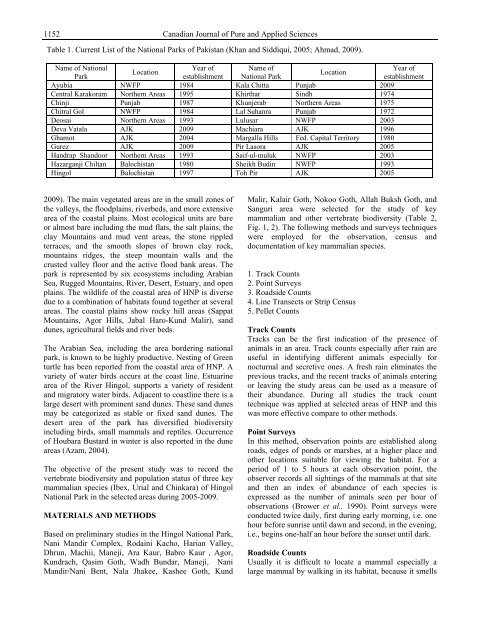Download (5Mb) - Covenant University Repository
Download (5Mb) - Covenant University Repository
Download (5Mb) - Covenant University Repository
You also want an ePaper? Increase the reach of your titles
YUMPU automatically turns print PDFs into web optimized ePapers that Google loves.
1152<br />
2009). The main vegetated areas are in the small zones of<br />
the valleys, the floodplains, riverbeds, and more extensive<br />
area of the coastal plains. Most ecological units are bare<br />
or almost bare including the mud flats, the salt plains, the<br />
clay Mountains and mud vent areas, the stone rippled<br />
terraces, and the smooth slopes of brown clay rock,<br />
mountains ridges, the steep mountain walls and the<br />
crusted valley floor and the active flood bank areas. The<br />
park is represented by six ecosystems including Arabian<br />
Sea, Rugged Mountains, River, Desert, Estuary, and open<br />
plains. The wildlife of the coastal area of HNP is diverse<br />
due to a combination of habitats found together at several<br />
areas. The coastal plains show rocky hill areas (Sappat<br />
Mountains, Agor Hills, Jabal Haro-Kund Malir), sand<br />
dunes, agricultural fields and river beds.<br />
The Arabian Sea, including the area bordering national<br />
park, is known to be highly productive. Nesting of Green<br />
turtle has been reported from the coastal area of HNP. A<br />
variety of water birds occurs at the coast line. Estuarine<br />
area of the River Hingol, supports a variety of resident<br />
and migratory water birds. Adjacent to coastline there is a<br />
large desert with prominent sand dunes. These sand dunes<br />
may be categorized as stable or fixed sand dunes. The<br />
desert area of the park has diversified biodiversity<br />
including birds, small mammals and reptiles. Occurrence<br />
of Houbara Bustard in winter is also reported in the dune<br />
areas (Azam, 2004).<br />
The objective of the present study was to record the<br />
vertebrate biodiversity and population status of three key<br />
mammalian species (Ibex, Urial and Chinkara) of Hingol<br />
National Park in the selected areas during 2005-2009.<br />
MATERIALS AND METHODS<br />
Based on preliminary studies in the Hingol National Park,<br />
Nani Mandir Complex, Rodaini Kacho, Harian Valley,<br />
Dhrun, Machii, Maneji, Ara Kaur, Babro Kaur , Agor,<br />
Kundrach, Qasim Goth, Wadh Bundar, Maneji, Nani<br />
Mandir/Nani Bent, Nala Jhakee, Kashee Goth, Kund<br />
Canadian Journal of Pure and Applied Sciences<br />
Table 1. Current List of the National Parks of Pakistan (Khan and Siddiqui, 2005; Ahmad, 2009).<br />
Name of National<br />
Park<br />
Location<br />
Year of<br />
establishment<br />
Name of<br />
National Park<br />
Location<br />
Year of<br />
establishment<br />
Ayubia NWFP 1984 Kala Chitta Punjab 2009<br />
Central Karakoram Northern Areas 1995 Khirthar Sindh 1974<br />
Chinji Punjab 1987 Khunjerab Northern Areas 1975<br />
Chitral Gol NWFP 1984 Lal Suhanra Punjab 1972<br />
Deosai Northern Areas 1993 Lulusar NWFP 2003<br />
Deva Vatala AJK 2009 Machiara AJK 1996<br />
Ghamot AJK 2004 Margalla Hills Fed. Capital Territory 1980<br />
Gurez AJK 2009 Pir Lasora AJK 2005<br />
Handrap Shandoor Northern Areas 1993 Saif-ul-muluk NWFP 2003<br />
Hazarganji Chiltan Balochistan 1980 Sheikh Budin NWFP 1993<br />
Hingol Balochistan 1997 Toh Pir AJK 2005<br />
Malir, Kalair Goth, Nokoo Goth, Allah Buksh Goth, and<br />
Sanguri area were selected for the study of key<br />
mammalian and other vertebrate biodiversity (Table 2,<br />
Fig. 1, 2). The following methods and surveys techniques<br />
were employed for the observation, census and<br />
documentation of key mammalian species.<br />
1. Track Counts<br />
2. Point Surveys<br />
3. Roadside Counts<br />
4. Line Transects or Strip Census<br />
5. Pellet Counts<br />
Track Counts<br />
Tracks can be the first indication of the presence of<br />
animals in an area. Track counts especially after rain are<br />
useful in identifying different animals especially for<br />
nocturnal and secretive ones. A fresh rain eliminates the<br />
previous tracks, and the recent tracks of animals entering<br />
or leaving the study areas can be used as a measure of<br />
their abundance. During all studies the track count<br />
technique was applied at selected areas of HNP and this<br />
was more effective compare to other methods.<br />
Point Surveys<br />
In this method, observation points are established along<br />
roads, edges of ponds or marshes, at a higher place and<br />
other locations suitable for viewing the habitat. For a<br />
period of 1 to 5 hours at each observation point, the<br />
observer records all sightings of the mammals at that site<br />
and then an index of abundance of each species is<br />
expressed as the number of animals seen per hour of<br />
observations (Brower et al., 1990). Point surveys were<br />
conducted twice daily, first during early morning, i.e. one<br />
hour before sunrise until dawn and second, in the evening,<br />
i.e., begins one-half an hour before the sunset until dark.<br />
Roadside Counts<br />
Usually it is difficult to locate a mammal especially a<br />
large mammal by walking in its habitat, because it smells

















